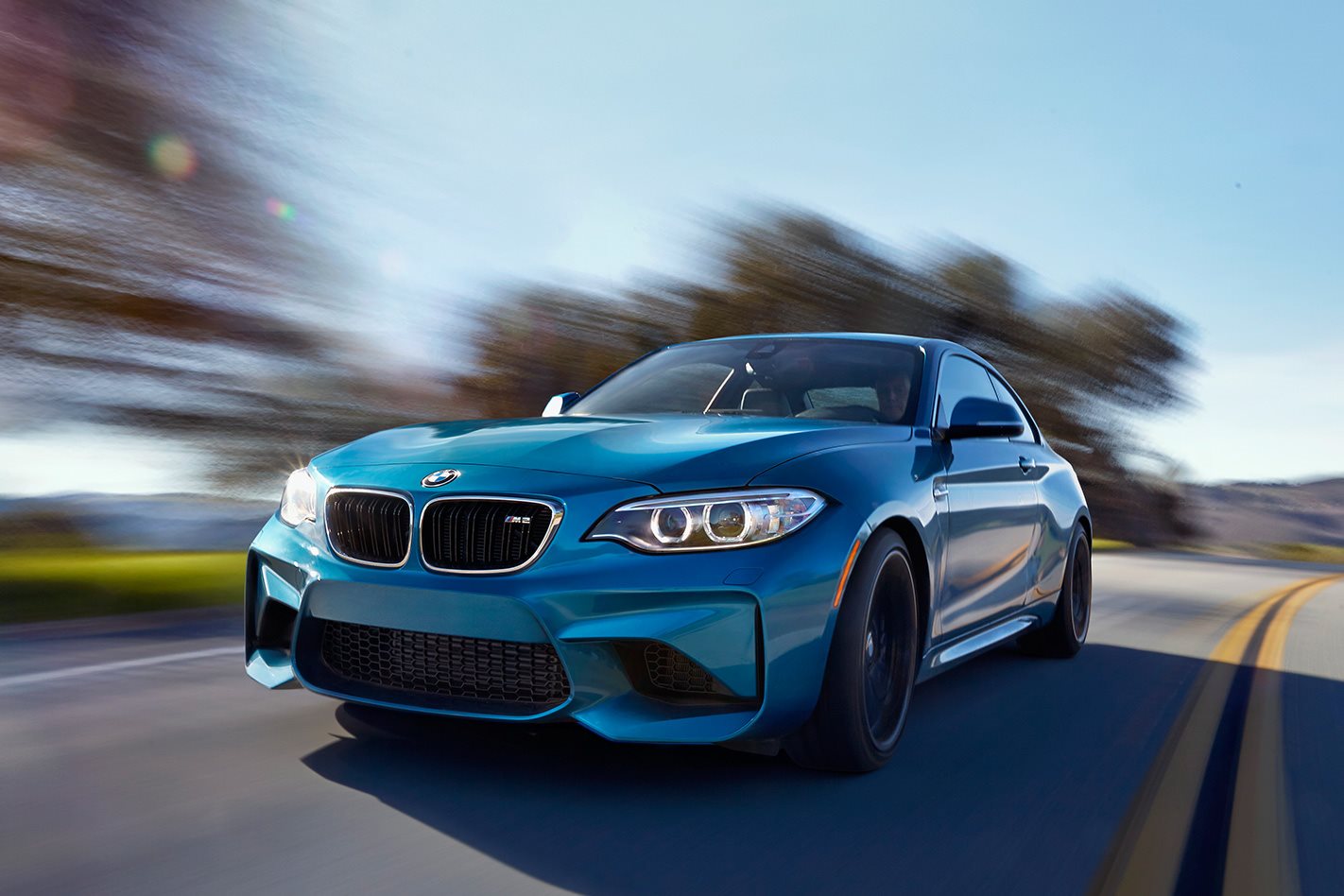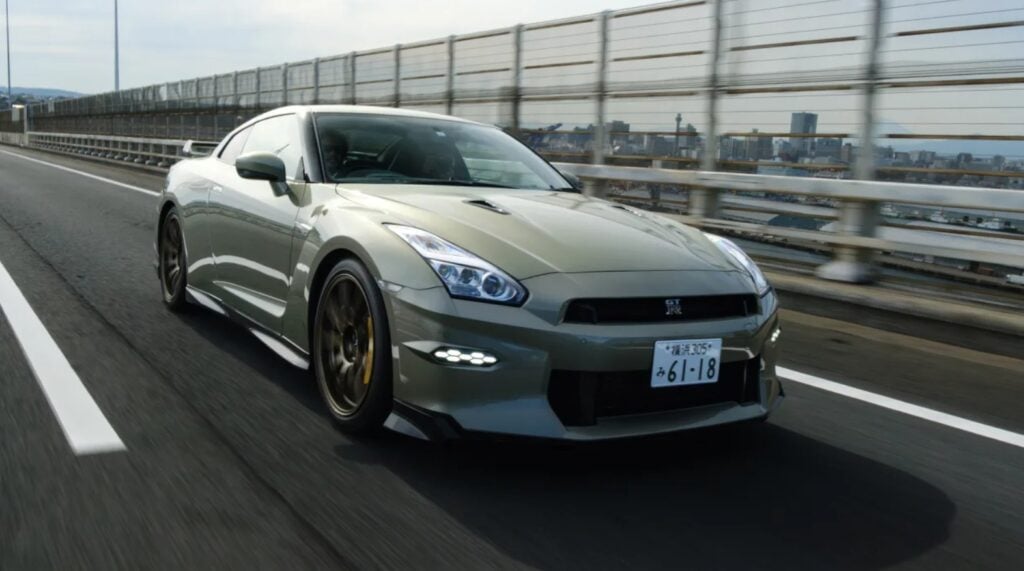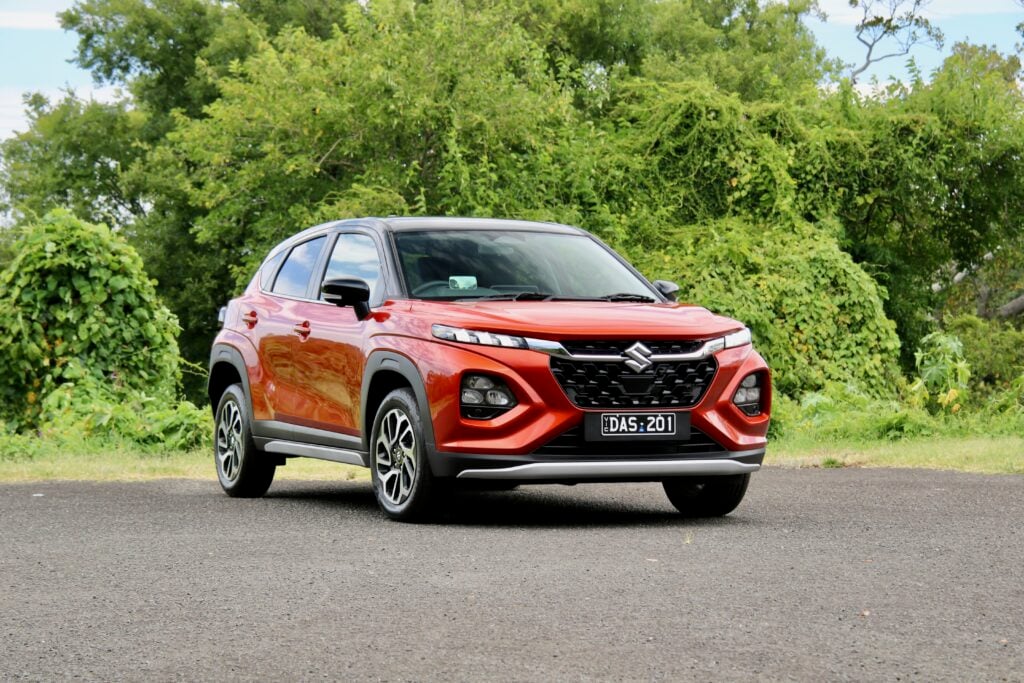You may have never driven the iconic Laguna Seca circuit on California’s central coast, but you surely know it.
You know the daunting, spiralling drop they call the Corkscrew as vividly as you do Bathurst’s Dipper. You have watched cars (and bikes) get loose over the blind crest on the approach to the Andretti Hairpin. Your mind has strafed the apexes of the ultra-fast double left-hander leading up to the Rahal Straight.
It’s not a long track, but it is an epic one, lazily flung over a lumpy dry lakebed back in the mid-’50s. And it’s a circuit that’s now rightly seared into the memory banks of any true petrol head.
Yet here’s a fact you may not have seen coming: the new BMW M2 feels as though it knows Laguna Seca, too. Far from wilting under the punishment this place dishes out, the M Division’s new junior entrant laps it up, feeling reassuringly composed under max attack, as well as wonderfully edgy and entertaining.
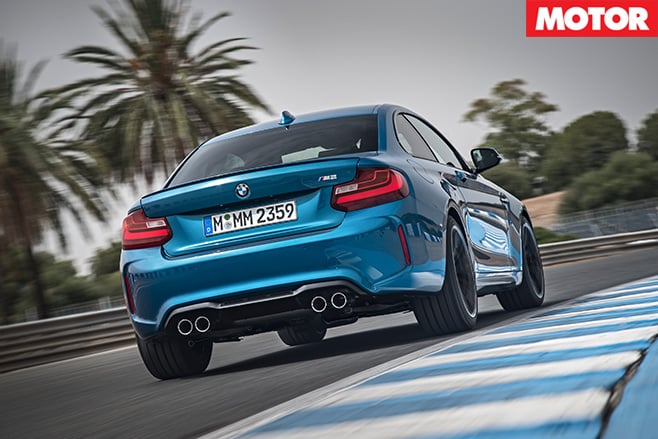
Priced from just $89,000 (manual-only Pure), the M2 undercuts big-bro M4 by around $50,000. It is set to compete in the zone occupied by Audi’s RS3 ($78,900) and Merc’s AMG A45 ($75,800), and it justifies the price premium over the $77,500 M235i by incorporating a number of key M4 hardware elements. It’s also far more mature and refined than its predecessor: the edgy, angry little 1 Series M Coupe from 2011.
Consider the focus: while the M235i can be had as a convertible, or even in all-wheel-drive form in overseas markets, the M2 is offered only as a rear-drive coupe.
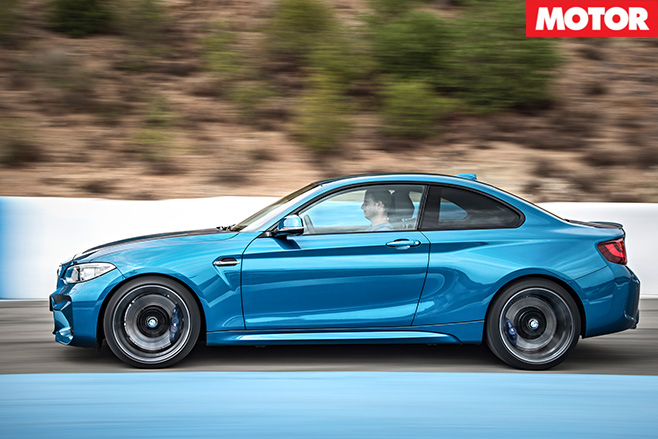
Visually and conceptually, the M2 picks up the theme pioneered by the 2002 Turbo and carried on by the 1 Series M Coupe. Being crafted around the evolutionary 2 Series body is a fine start. The black 19-inch wheels with polished double spokes, the lipped bootlid framed by LED tail-lights, and the M4 overtones, including the trademark M fins in both front guards, all make the visual message clear.
Those guards also incorporate vents to reduce drag resistance and increase downforce, while the mean-looking sculpted front bumper runs three hungry air intakes. Neatly crafted side skirts and a bespoke rear apron housing the four chromed tailpipes complete the exterior changes. It’s predictably M, but it’s cohesive and convincing.
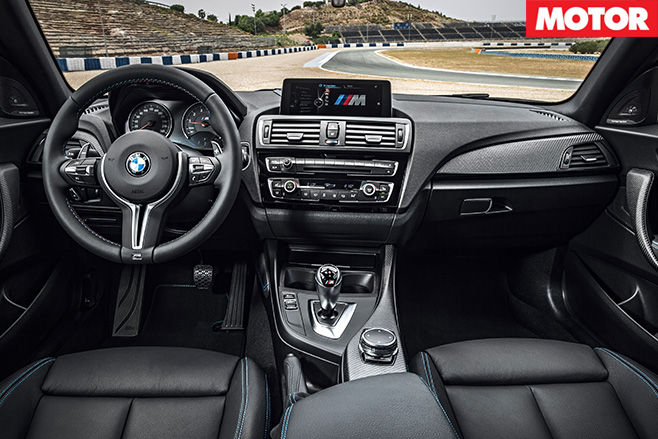
Our test car is equipped with the manual transmission and weighs in at a claimed 1495kg. As we head out for a road drive, I search the back of my mind for recollections of the 1M Coupe and the current M4. Like the 1 Series M Coupe and the M4, the M2 relies on a turbocharged 3.0-litre in-line six, here rated at 272kW/465Nm; the M4 motor is good for 317kW/550Nm.
So it should cop a belting from its big brother, right? Not quite. On track the M4 lead car fought a neck-and-neck race with our M2 without once managing to open up a noteworthy gap. Through second- and third-gear turns, the lighter and more chuckable M2 neutralised the power and torque advantage of its bigger stablemate.
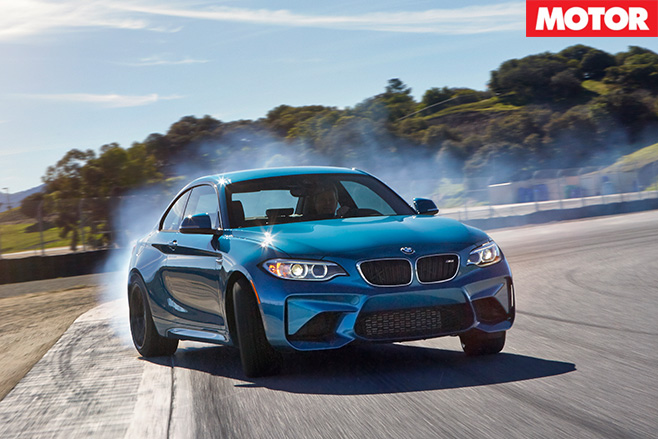
The narrow performance gap shrinks further to a token one tenth when you compare the fourth-gear acceleration times from 80-120km/h – a claimed 3.5sec against 3.6sec. As far as the top speeds are concerned, both the M2 and M4 are limited to 250km/h. Opt for the M Driver’s Package and the reprogrammed limiter will permit 270km/h and 280km/h respectively, although it’s a marginal difference and of little relevance to Aussie buyers.
More curious is the spec strategy. Unlike most of its rivals, the M2 takes a one-spec-fits-all approach. To keep cost and complexity to a minimum, nice-to-have options including the adaptive M suspension, M carbon-ceramic brakes, M Competition Pack and adjustable damper settings are conspicuous by their absence.
Instead, the junior M car relies on non-adjustable springs and dampers, a run-of-the-mill driving experience selector (mode switch), and the useful M Dynamic Program (MDM), which fuses a quicker steering action with a more liberal stability control and a diff that delivers mild power oversteer.
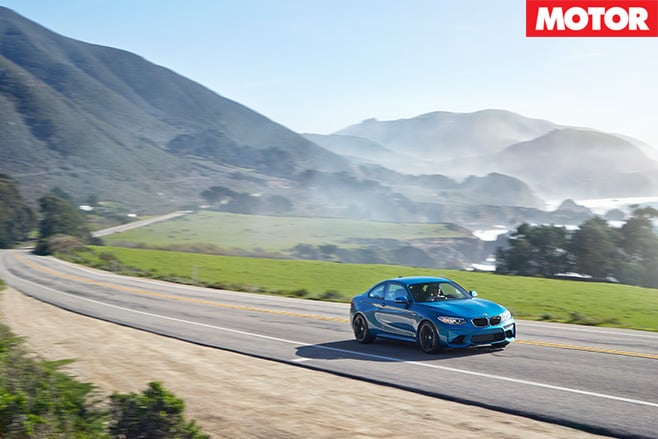
Despite this dynamic focus, there’s enough compliance built into the chassis and the Michelin Pilot Sport tyres to absorb midsize potholes, yawning cracks in the tarmac, camber variations and washboard surfaces. Compliance is a big step towards control, and control is a prerequisite for confidence.
Compliance smooths the flight path of the M2 by filtering out any nervousness or uncouth behaviour on imperfect blacktop, banishing vertical disturbances and clearing the communication path from road to car to driver.

The front end has clearly been tuned to soak up serious topographic vagaries before they upset the car’s composure or feed negative messages through the steering wheel. The rear end, fat and squat, has a slightly narrower tolerance zone, which can easily be squashed to zero by loading up the rear wheels with torque on slippery or pock-marked terrain; rather than just unleashing the upper end of the power curve.
It’s a contrast to the more brittle, firmer and quite aggressive set-up of the M4, a car known to activate DSC intervention even at 240km/h on a bumpy autobahn. The 1 Series M Coupe was even rougher and cruder, and it was so unsettled and twitchy at very high speeds that M Division elected to offer a retrofit stabilising aero kit on request.

Lift off in the middle of a 160km/h bend taken at nine-tenths? No problem. A quick lane change combined with crosswinds? Drama-free. Jamming on the brakes at autobahn speed, ready for an emergency swerve onto the hard shoulder? No sweat. The absolute deceleration is sufficiently urgent, and that hair-raising rear-to-front weight transfer which threatened to kick the 1M Coupe off line has all but disappeared.
On track the MDM keeps the car on a short leash. But with DSC off, the M2 is keen to leave its black rubber signature on the bitumen and deliver an almost cinematic throttle-steer experience. The wider front track not only sharpens the turn-in, it also adds an extra dash of stability to the cornering bite.

The creamy and predictable handling remains intact through the slower twisties, in and out of hairpins, cutting uphill curves, or when carving down winding descents with screeching enthusiasm.
Unlike the M coupe, which needed to be wrestled hard from apex to apex, and unlike the M4 which is blunter and less patient, the M2 wants to please and entertain. It has fewer rough edges than the other two M cars, its limits have a reassuringly wide boundary, and its fractionally less emphatic reactions to inputs make it more linear and less tricky.
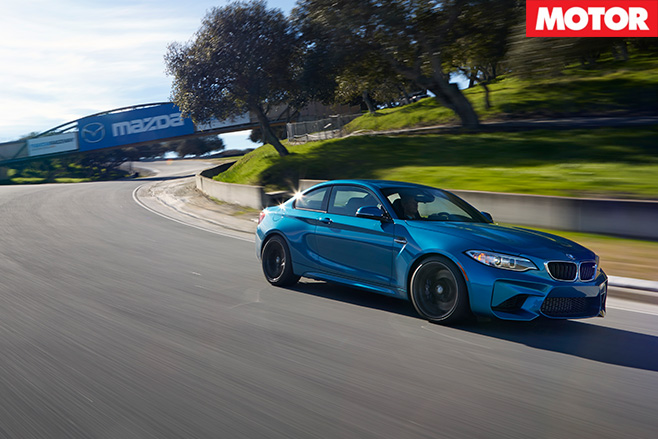
The M2’s rack, thankfully, doesn’t illicit those feelings. In Sport, the speed-sensitive support is unobtrusive, but never gluggy or dulled. Even the critical transition from the unassisted straight-ahead position to any degree of lock is imperceptibly smooth. While the helm firms up ever so slightly to help maintain a chosen angle, it refrains from enhancing or diminishing the overall steering weight. And I’ll say this: memory may be a fickle thing, but I’d argue that the M2 steering could be a match for the E46 M3 in terms of haptic clarity and fluent action.
The M2 comes standard with the so-called M compound brakes borrowed from the M4, which are lighter and more powerful than the stoppers on the M235i. The bigger drilled and inner-ventilated cast-iron discs – 380mm in the front; 370mm in the rear – and the fatter blue calipers bite at the first stab and arrest as much energy as the driver’s right hoof can summon.

The days of the normally aspirated BMW six-cylinder petrol engine are long gone. Having said that, not every straight-six turbo out of Munich is genetically related. The M2 engine uses the same pistons as the M4 unit, but it’s not a bespoke M division powerplant; rather, it’s an upgraded AG engine. Despite the TwinPower nomenclature, boost pressure is provided by a single twin-scroll turbo. The power curve peaks at 6500rpm where 272kW is on tap.
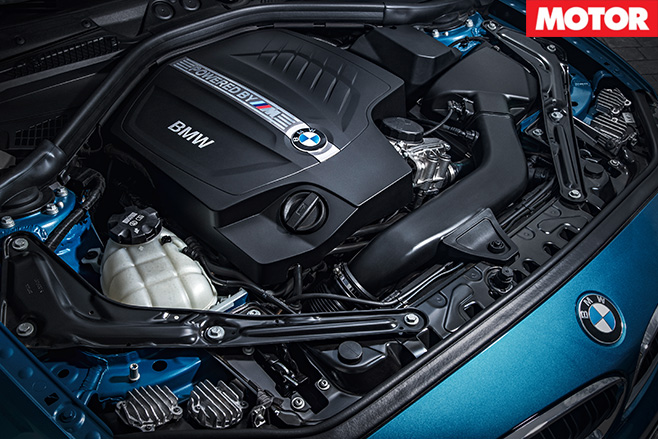
But it does like a drink. BMW quotes a combined fuel consumption of 8.5L/100km, which is realistic wherever speed limits are strictly enforced. In a more liberal environment, however, it took us less than 300km to empty the 52-litre tank (two hours later the second fill was also half-drained).
Redlined at 7000rpm, the M2 engine attempts to combine the best of both worlds: a distinct willingness to rev and enough grunt to spin the rear wheels in second gear, in the dry. The M4 is the more vocal car, but its little brother still sports a voice which ranges from velvety to irate. The mechanical noises are dense, loud and sonorous. As the engine speed picks up, the hum becomes a throb, then a roar, to barely street-legal thunder.
But which transmission to choose? The six-speed manual is commendably quick and slick, and in Sport or Sport Plus the software will automatically blip the throttle as you downshift.

Confession time: I don’t find the competent but cold M4 truly desirable. For me, the M4 feels a bit like a slimmer and more compact M6, while the M2 feels to be a different animal; closer in both ability and emotional connection to the coveted E46 M3. But I need to know for sure.
So before it gets dark, we find an empty country road within striking distance of Laguna Seca – nearly 30km of winding, diving, rush-out bliss. There’s enough time left for a brisk recon to check out the tricky sections and to scan the lay-bys and side roads for cops in hiding.

In many ways, this entry-level M car encapsulates qualities we thought the revered M Division had left behind about two generations ago. How brilliant to see them back.
4.5 out of 5 stars
Specs Body: 2-door, 2+2-seat coupe Drive: rear-wheel Engine: 2979cc straight-6, DOHC, 24v, turbo Bore/stroke: 84.0 x 89.6mm Compression: 10.2:1 Power: 272kW @ 6500rpm Torque: 465Nm @ 1400-5560rpm Power/weight: 182kW/tonne Transmission: 6-speed manual Weight: 1495kg Suspension (F): struts, A-arms, dampers, anti-roll bar Suspension(R): multi-links, coil springs, dampers, anti-roll bar L/W/H: 4468/1854/1410mm Wheelbase: 2693mm Tracks: 1579/1601mm Steering: electrically-assisted rack-and-pinion Brakes (F): 380mm ventilated discs; 4-piston calipers Brakes (R): 370mm ventilated discs; 2-piston calipers Wheels: 19.0 x 9.0-inch (f); 19 x 10.0-inch (r) Tyre sizes: 245/35 ZR19 93Y (f); 265/35 ZR19 98Y (r) Tyres: Michelin Pilot Super Sport (f/r) Pros: Return to form for M division; handling; pace; involvement Cons: Could handle more grunt; small fuel tank Price: $89,900 (Pure)

